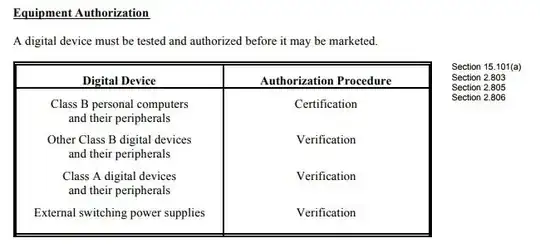I've built a small consumer device that contains an Arduino Nano. It's coupled to a custom daughter board that allows it to pulse a 12V electromagnet at about 1 hertz as well as inteface to some sensors. It does not intentionally produce any RF emissions like wifi or bluetooth.
I'd like to sell my device in the US, and I'm trying to determine what certification I need to legally sell it. From what I've read about FCC certification, including similar questions here, it's needed by nearly all electronic devices that oscillate above 9 kHz.
So, if I understand this correctly, my custom daughter board wouldn't require FCC certification? The Arduino Nano contains a clock that oscillates at 16 MHz, but I believe it already has FCC certification. Does my composite device constitute something that needs to be re-certified by an FCC approved testing lab? I'm not sure how much I'll be able to sell the device for, and don't expect to make much money, so if I can avoid wasting $10,000 on worthless certification for an unintentional emitter, I'd like to do so.
I'm not sure if this is an appropriate question for this site. If it's not, where could I find an answer to this? I've checked the FCC's website, but aside from vague FAQs, I can't find any way to contact anyone with a clue. I've seen some test labs offering to give me a quote to answer this question, but since they have nothing to gain by telling me "no don't bother paying us thousands to test your device", I'm hesitant to trust a response from them.

(3) The probably now rather rare lowish cost portable manually tuneable, (usually) black & white (typically 12 volt) TVs are excellent for finding signals in the VHF/UHF bands. They do not cover all frequencies but you can SEE signals and also heard them. If you pass the AM radio test well the TV is usually reasonably clean as well.
The manual tuning is MUCH more useful than station switched TVs which can easily miss signals.
– Russell McMahon Oct 04 '17 at 02:41